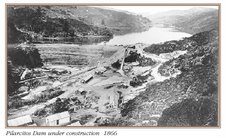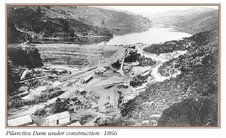Story by John Vonderlin
Email John: [email protected]


Hi June,
This article from the May 22nd, 1867 issue of “The Daily Alta,” is quite interesting. It gives many details you won’t find in the official website of “San Francisco’s Early Water Sources.” You especially won’t find the description of people being able to visit and enjoy this hidden gem that concludes this article. I’ll explain why in a later posting. Please note that apparently at this time the law allowed property holders in the upper reaches of a watershed to confiscate all the water on their property and ship it elsewhere. Note too the line referring to “a liberal supply running to waste.” That’s Half Moon Bay’s water supply they are referrring to. Enjoy. John
SPRING VALLEY WATER WORKS CELEBRATION OF THE COMPLETION OF THE TUNNEL— PROJECTED WORK — THE DAM— VOLUME OF WATER, ETC, ETC.
Yesterday, the 21st inst., a number of tbe Directors and officers of tbe Spring Valley Water Works, together with several guests, met at the works of the Spring Valley Water Company, some twenty miles from the city, to inspect a new tunnel which has just been completed after nearly two years’ incessant work. A ride in the San Jose cars to the San Bruno station, and then by Concord wagons over fine roads, through valleys, over hills, up and down canyons until after some seven miles smart travelling the party came in sight of the artificial lake of pure, clear, cool, delicious water, nestled snugly amid towering hills and mountains. The lake is composed of two arms, in one of which the water has been backed up over a mile and a half, and in the other about three-fourths of a mile. The greatest depth of the water is about eighty feet, the whole lake containing at the present time eight hundred and twenty-five million 825,000,000 gallons of water, with a liberal supply running to waste.
THE TUNNEL, AND WHY BUILT.
When the Spring Valley Company was in its infancy, a small dam was constructed near the head of a water course, into which the water of several creeks were brought and stored in the rainy season for summer use. A wooden flume was then laid from this reservoir to the city, following the configuration of the country, making the distance some forty-five miles. Experience having demonstrated the great extent of the supply of water, even in the dryest seasons, the Company went to work and constructed a larger dam, and ran a tunnel to cut off distance in the fluming, saving in the wastage and fall of water. By constructing a tunnel 3,834 feet under a hill over 500 feet high, more than seven miles of fluming will be dispensed with and forty feet in height gained. Two years since, the construction of the tunnel was decided upon, and on the 20th of July, ground was broken, and the work finally completed on the 20th of this month, making twenty-two months work, night and day. Mr. H. Schussler, engineer of the Company, laid out the tunnel, and Mr. R. P. Denoon contracted to do the work. The tunnel is six feet two inches high and five feet six inches wide at the base, timbered throughout with plank six by eight inched, and the sides and ceiling covered with two-inch boards. The entire length of the tunnel is now to be laid in brick and cement, and then the water run through it. The tunnel is cut in a straight line and worked from both ends, and when the two parties of drifters met they found only three-sixteenths of an inch difference in their levels at the centre. The outlet end is six feet lower than the supply mouth, giving plenty of fall to run through a large body of water. Considerable blasting was done, and eighty kegs of powder used, though a great deal of the work was picking through a clay earth. A new tunnel in the vicinity of Lake Honda was commenced on the 7th of November last, which is to be 2,820 feet in length, and of larger dimensions than the one just finished. This will save between four and five more miles of fluming, increase the fall of the water, so as to let it into Lake Honda twenty feet higher than the present end of the flume and consequently allow the dams at the lake to be raised a corresponding height. The increased holding capacity of the lake will be many million gallons.
THE DAM AND LAKE.
The present dam was commenced early in 1865, and finished to its present height in 1867, though the water was taken from it during the greater part ot the past two years. As soon as it was high enough to supply the city, water was let into the flume. and work kept constantly going on until it was elevated 76 feet from the base, and contains, as stated above, at the present time 825.000,000 gallons of water.
The Company finding the demand for water increasing and a vast quantity lost each winter, concluded to elevate the dam so as to reach a height of 96 feet, and that work is now going on with a full force of men, calculated to finish it by October next, when the capacity will be one thousand three hundred million (1,300,000,000) gallons stowed away for a dry day. The old adage admonishes ,”Lay up for a rainy day,” but the Water Company was arranging to store this liberal supply for the “dry season” when the creeks and rivulets are apt to run dry, or nearly so.
The dam is four hundred and fifty feet through at the base, and tapers to twenty feet at the greatest height, (ninety six feet) being built like a pyramid with a slope on each side. The length of the dam on the top across the canyon is four hundred and fifty feet. There will have been used in its construction the enormous amount of 850,000 cart loads of earth, to haul which, it would take one man, at thirty loads per day, and three hundred working days per year, between ninety-four and ninety-five years.
ODDS AND ENDS
A large amount of work has been done by the Company in addition to that described, and everything in a solid and substantial manner. A fine road has been built from the old San Bruno House into the Company’s works, much of it being cutting and filling. A ride over this six or seven miles. at this season of the year, it most delightful, the whole face of the country wearing its spring garden of flowers, and grass, and grain, with lowing herds of fat, lazy cattle, which scarce deign to raise their heads as the rider dashes past them. The views from the various passes in the hills are enchanting, revealing now a snug, smiling valley, then a wild, wooded canyonn, and at another turn the broad expanse of the Bay, with the Contra Costa range of mountains, capped by the peaks of Mount Diablo. For a day’s ride, get up with the sun and start off in the geniall warmth of a San Francisco morning: a lunch basket stowed under the seat of a buggy or rockaway; a genial companion; (female, if you like it) a sail on the lake; a few hours’ trout fishing; a good drink of pure water at the fountain head: talk, romance, poetry or soft nonsense, if you please: start back at three or four o.clock, and get to town as the shades of evening close around, and you will be just tired enouch to enjoy a good, sound night’s sleep and feel better for a week or ten days after. Mr. W. H. Lawrence, the Superintendent of the Spring Valley Water Works, resides at the lake, and though always busy with his work, can spare a .few moments to point out the visitor the many interesting spots in and around Spring Valley.
